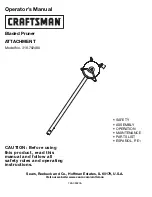
14
4. Compound cutting
Compound cutting is the process in which a bevel angle
is made at the same time in which a miter angle is being
cut on a workpiece. Compound cutting can be performed
at angle shown in the table.
When performing compound cutting, refer to “Press cut-
ting”, “Miter cutting” and “Bevel cut” explanations.
5. Cutting aluminum extrusion (Fig. 31)
When securing aluminum extrusions, use spacer blocks
or pieces of scrap as shown in
Fig. 31
to prevent defor-
mation of the aluminum. Use a cutting lubricant when
cutting the aluminum extrusion to prevent buildup of the
aluminum material on the blade.
CAUTION:
• Never attempt to cut thick or round aluminum extru-
sions. Thick aluminum extrusions may come loose dur-
ing operation and round aluminum extrusions cannot
be secured firmly with this tool.
6. Wood facing (Fig. 32)
Use of wood facing helps to assure splinter-free cuts in
workpieces. Attach a wood facing to the guide fence
using the holes in the guide fence.
See
Fig. 32
concerning the dimensions for a suggested
wood facing.
CAUTION:
• Use straight wood of even thickness as the wood fac-
ing.
• Use screws to attach the wood facing to the guide
fence. The screws should be installed so that the screw
heads are below the surface of the wood facing.
• When the wood facing is attached, do not turn the turn
base with the handle lowered. The blade and/or the
wood facing will be damaged.
7. Cutting repetitive lengths (Fig. 33)
When cutting several pieces of stock to the same length,
ranging from 240 mm to 400 mm, use of the set plate
(optional accessory) will facilitate more efficient opera-
tion. Install the set plate on the holder (optional acces-
sory) as shown in
Fig. 33
.
Align the cutting line on your workpiece with either the
left or right side of the groove in the kerf board, and while
holding the workpiece from moving, move the set plate
flush against the end of the workpiece. Then secure the
set plate with the screw. When the set plate is not used,
loosen the screw and turn the set plate out of the way.
NOTE:
• Use of the holder-rod assembly (optional accessory)
allows cutting repetitive lengths up to 2,200 mm (7.2 ft.)
approximately.
Carrying tool
Make sure that the tool is unplugged. Secure the blade at
0° bevel angle and the turn base at left miter angle fully.
Lower the handle fully and lock it in the lowered position
by pushing in the stopper pin.
(Fig. 34)
Carry the tool by carrying grip as shown in
Fig. 35
. If you
remove the holders, dust bag, etc., you can carry the tool
more easily.
(Fig. 35)
CAUTION:
• Always secure all moving portions before carrying the
tool.
• Stopper pin is for carrying and storage purposes only
and not for any cutting operations.
MAINTENANCE
CAUTION:
• Always be sure that the tool is switched off and
unplugged before attempting to perform inspection or
maintenance.
WARNING:
• Always be sure that the blade is sharp and clean for the
best and safest performance.
Adjusting the cutting angle
This tool is carefully adjusted and aligned at the factory,
but rough handling may have affected the alignment. If
your tool is not aligned properly, perform the following:
1. Miter angle (Fig. 36)
Loosen the grip which secures the turn base. Turn the
turn base so that the pointer points to 0° on the miter
scale. Tighten the grip and loosen the hex bolts securing
the guide fence using the socket wrench.
Lower the handle fully and lock it in the lowered position
by pushing in the stopper pin. Square the side of the
blade with the face of the guide fence using a triangular
rule, try-square, etc. Then securely tighten the hex bolts
on the guide fence in the order from the right side.
(Fig. 37)
2. Bevel angle
1) 0° bevel angle
Lower the handle fully and lock it in the lowered posi-
tion by pushing in the stopper pin. Loosen the lever at
the rear of the tool. Loosen the hex nut and turn the 0°
bevel angle adjusting bolt on the right side of the arm
two or three revolutions clockwise to tilt the blade to
the right.
(Fig. 38)
Carefully square the side of the blade with the top sur-
face of the turn base using the triangular rule, try-
square, etc. by turning the 0° bevel angle adjusting
bolt counterclockwise. Then tighten the hex nut to
secure the 0° bevel angle adjusting bolt and tighten
the lever securely.
(Fig. 39)
Make sure that the pointer on the turn base point to 0°
on the bevel scale on the arm. If it does not point to 0°,
loosen the screw which secures the pointer and adjust
the pointer so that it will point to 0°.
(Fig. 40)
Bevel angle
Miter angle
45°
Left and Right 0 – 45°
Summary of Contents for LS1040F
Page 2: ...2 8 9 10 11 12 13 14 15 1 2 3 4 5 6 7 8 2 1 3 6 4 5 7 ...
Page 3: ...3 21 19 22 20 32 9 10 11 12 13 14 15 16 17 16 18 23 24 25 26 27 28 29 30 31 33 34 ...
Page 5: ...5 67 68 65 66 76 75 74 73 77 25 26 27 28 29 30 31 58 60 59 64 61 62 63 69 70 72 71 ...
Page 7: ...7 91 93 92 94 97 95 96 99 98 101 100 104 102 103 102 106 105 108 109 39 40 41 42 43 44 ...
Page 101: ...101 ...
Page 102: ...102 ...
Page 103: ...103 ...















































